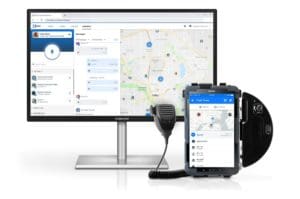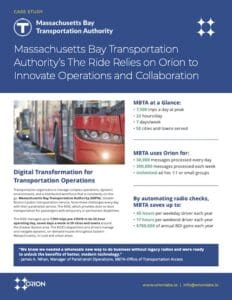Transforming Transit Operations with Unified Communications and PTT 2.0
Public transportation organizations continuously strive to improve the passenger experience, on-time reliability, and safety — especially as cities emerge from COVID-19 pandemic measures. Funds from COVID-19 Economic Relief and the Infrastructure Investment and Jobs Act mean many transportation organizations have the reserves to reevaluate longstanding approaches to transit and address some of their biggest challenges, especially when it comes to technology and communications.
Many of today’s transportation organizations face the same communications challenges — often due to legacy technology like radios. These challenges stall innovation and hinder efforts to improve productivity and safety.
Here are 4 of the top public transportation communications challenges in 2022:
- Aging Legacy Technology
- Limited Communications Environments
- Limited Organizational Visibility and Real-Time Location Information
- Reliance on Manual Processes
Get the Massachusetts Bay Transportation Authority Case Study
4 Challenges Hindering Communications for Public Transportation Operations:
#1 Aging Legacy Technology:
Many public transportation organizations know they need to move away from legacy technology like radios, whether their operations are fixed-route or on-demand. Radio technology is burdensome to maintain and offers limited value for the investment. Driver connectivity is limited by range, resulting in uncertainty when operating in unfamiliar or remote environments.
#2 Limited Communications Environments:
Dynamic operations require the ability to bring relevant parties into ad-hoc 1:1 or limited group environments. However, legacy technology often locks teams into All-Call communications environments or requires drivers to manually change channels during an incident or emergency.
Legacy technology like radios prohibits expanding the collaboration environment as needed. Support staff, customer service, safety personnel, managers, and more are often locked out of the collaboration environment due to limited scalability and the requirement to add hardware. Today’s operations need to scale their fleet to meet a surge in demand without adding extra, expensive hardware.
#3 Limited Organizational Visibility and Real-Time Location Information:
Driver and passenger safety are mission critical, yet, many public transportation systems lack real-time driver location information. Whether drivers are completing dynamic or static routes, dispatchers need real-time visibility to ensure driver and passenger safety, as well as driver accountability and the completion of assigned routes.
#4 Reliance on Manual Processes:
Outdated technology often leads to outdated, manual processes. For too many public transit operations, manual processes are holdovers from legacy systems. Take a simple radio check. Every driver must complete multiple radio checks per shift to ensure they are able to reach dispatch and are receiving communications. It’s standard practice for radio operators to spend hours each day responding to each radio check. Manual, repetitive processes like these keep operations from achieving greater efficiency.
Learn About Orion for Transportation
PTT 2.0 and Solving Public Transportation Communications Challenges
Fortunately, advancements in technology have created innovative solutions that address each of the challenges outlined above. Push-to-Talk (PTT) 2.0 uniquely brings distributed workers, dispatchers, and support staff together on one scalable platform. As part of a Unified Communications strategy, PTT 2.0 provides the innovative communications solution transportation organizations need to connect their workforce and future-proof their operations.
Here are a few ways PTT 2.0 addresses public transportation communications challenges:
Expanded Collaboration:
Unlike legacy radios, PTT 2.0 is instantly scalable — a non-negotiable requirement for today’s communications technology. Users can download the solution via tablet or smartphone or access the web-based Dispatch Console via browser. Unconstrained radio range, dispatchers access the Dispatch Console from any location, including a home office, operations center, or on the go.


Instant scalability has several advantages for transportation organizations. Dispatchers gain greater flexibility during incident response to control the collaboration environment. They can move a driver into an ad-hoc 1:1 or limited group environment and include the relevant safety or supervisory personnel. Leaders-only groups reduce distractions by limiting the communications drivers hear just to Dispatch messages — and not all online drivers. Drivers keep focused on their tasks, gain undivided attention from Dispatch, and improve safety response.
Dispatchers can also easily add support staff to the collaboration environment. Before, they required additional radio hardware. Now, cross-departmental collaboration is easy between drivers, dispatchers, customer service, emergency responders, maintenance, supervisors, and more. Organizations can quickly scale to meet demand. Adding new or temporary drivers and vehicles to communications is seamless.
Greater Operational Control:
Today’s transportation organizations require a complete view of their operations. Real-time, centralized visibility and locations of a distributed workforce ensure safety and productivity. This oversight results in more effective Control Centers with operations managers, supervisors, customer service representatives, and dispatchers making more informed decisions.
Users never miss a message with the ability to record, playback, and archive all messages. This Message Archive functionality also enables organizations to bulk download and review all prior messages sent and received. Organizations gain the ability to analyze and improve quality control and preserve the archived messages for compliance.
Process Automation with Voice AI Bots:
Today’s teams need voice automation bots that take on the routine work that teams repeat each and every day. PTT 2.0 uses Voice AI Bots to supercharge innovation and automation to improve the transportation industry’s productivity, safety, and customer service. Automated Voice Bots can take on challenges like SOPs and checklists. Drivers quickly complete equipment inspections, radio checks, and status updates quickly and on time.
Geofence or location-based triggers are also a possibility with PTT 2.0. If a driver hasn’t moved for a designated amount of time, bots can trigger an alert to a dispatcher starting safety workflows. Dispatchers can quickly ensure the driver is safe, has the information they need, or is completing routes as assigned.
Voice-First Communication for Incident Response:
Rapid response in incidents is paramount for transportation operations to keep passengers and drivers safe. PTT 2.0 brings incident response into a centrally managed web-based console. Always-on Voice Bots are triggered automatically or manually by pre-determined voice commands, events, or actions.
Voice commands like “Help-Help-Help” or “Code Blue” kick-off emergency workflows sending email or SMS, audio, and geolocation information to dispatchers, response teams, and managers. Dispatchers can quickly create an ad-hoc communications environment, moving the driver out of an all-call group and adding all relevant personnel for rapid response. All communications are archived, enabling analysis post-event and supporting any compliance needs.
Innovating Transportation Operations with Orion’s PTT 2.0


Labor constraints, rising costs, and public safety requirements mean transportation organizations need innovation now more than ever. PTT 2.0 was built for the challenges of public transportation’s distributed, frontline workforce of drivers, dispatchers, customer service, operations managers, and more. Advancements in PTT 2.0 mean innovation is now more accessible than ever to the public transportation industry.
Ready to learn more about how PTT 2.0 can transform your operations? Contact me today.
You Might Also Like:
- Case Study: Massachusetts Bay Transportation Authority
- 4 Reasons Public Transportation Operations Need PTT 2.0
- Logistics and Transportation Review names Orion a “Top 10 Intelligent Transport Systems Solution Providers for 2021”
- Article: 4 Ways to Include Deskless Logistics Workers in Your Digital Strategy
- Transportation and Logistics Communications Need to Move Beyond Push-to-Talk and Radios
- E-book: 12 Reasons Radios Are Holding Your Company Back
- E-book: The Future of Voice at Work

